“On Danish life and work, on folk-school Atterdag – The sun shines in Solvang, a covenant of memory.” – Anton Kvist, c. 1920s
A Pastoral Palimpsest
Among the beach towns and farming communities scattered across Central California’s rolling hills, Solvang stands out as a pleasant anomaly. At a time when globalisation threatens to homogenise the character of cities, this quaint West Coast village has developed a unique identity precisely because of transnational immigration. Early in the 20th century, Danish settlers in the Santa Ynez Valley left an enduring imprint on Solvang’s built environment. The town’s image emerged by a process of ‘allopatric urbanisation’: the geographic separation between these settlers and their Scandinavian homeland resulted in a vicariant urban evolution. Danish customs mixed with American culture, creating a vibrant vernacular tradition in Solvang. Though rustic and remote, this Californian town demonstrates how the influx of new populations may have salutary effects on a place’s personality.
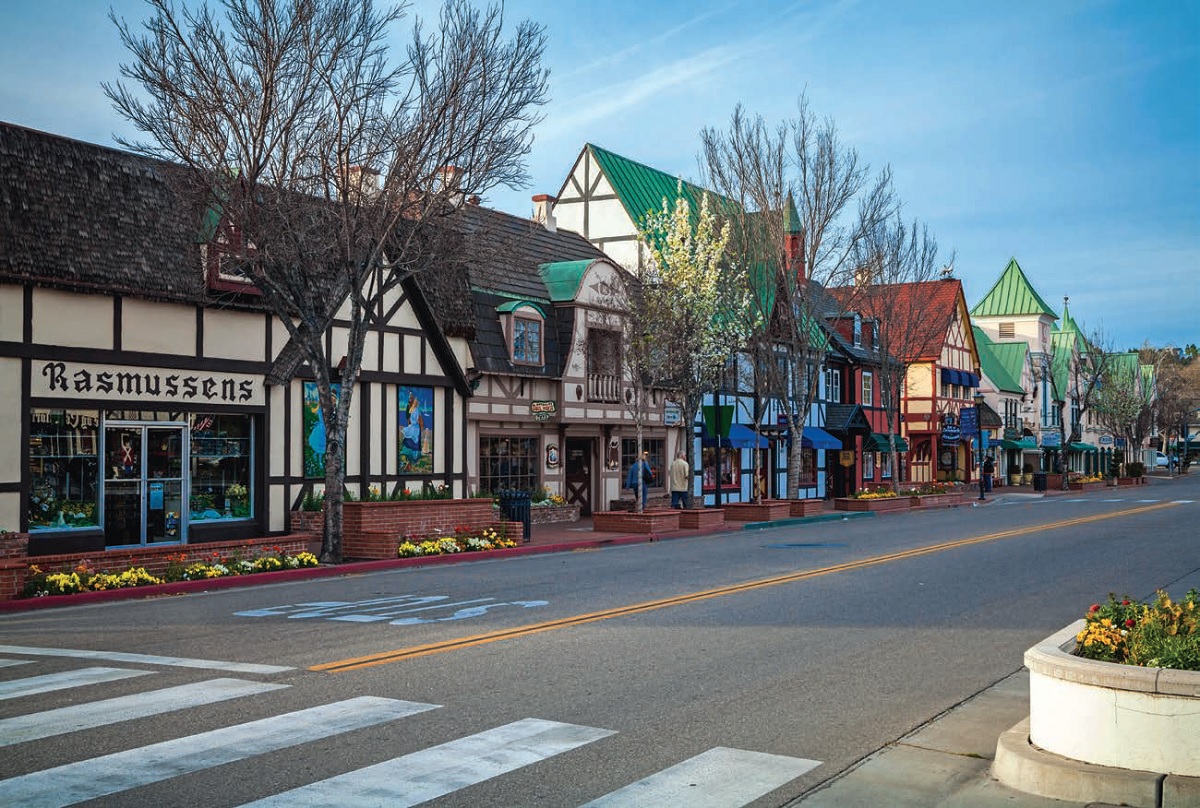
Source: “City of Solvang” by Sodanea Chea/ https://www.flickr.com
Before this area’s most recent European incarnation, the Chumash people resided on this land for thousands of years. Alajlapu, a Native American village, was located within modern-day Solvang, roughly where Mission Santa Inés is now. Their ephemeral buildings no longer stand, but archaeologists continue to discover artefacts in the area. Though their architecture has disappeared, the location of the Chumash town determined the site of the Catholic mission, around which modern Solvang grew.
 Source: Courtesy of Elverhøj Museum of History and Art | 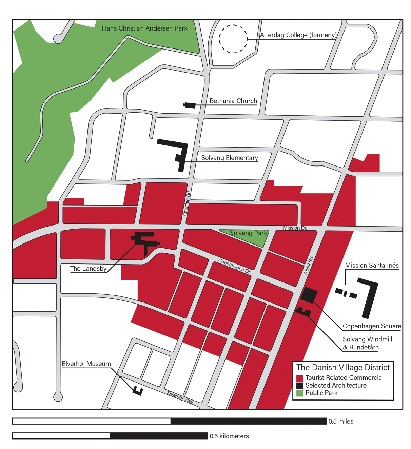 Source: author |
The Spanish founded missions such as Santa Inés in Native American communities, some of which became California’s major towns and cities. The state’s current settlement patterns are therefore an expression of an earlier aboriginal geography. Under Spanish supervision, Native American neophytes-built Mission Santa Inés in 1804. The complex was an inland waypoint between two other coastal missions as well as a hub for the valley’s Chumash villages. A significant agriculture network developed around Mission Santa Inés, and farming remains an important part of the region’s economy.
Today, this Catholic compound is no longer the area’s focal point. Along with a few other buildings across the street, it delineates the eastern edge of the downtown ‘Danish Village’ district. These structures, which include Solvang’s public library, belong to the Spanish colonial revival style inspired by California’s Hispanic past. At the time of their construction, the community hadn’t determined a specific city image. Although the Danish presence was already pervasive, Solvang wouldn’t adopt a Scandinavian architectural standard until later.
A Colony in California
Danes first arrived in the Santa Ynez Valley by way of the American Midwest, where a sizeable expatriate community already existed. The town’s founders moved there to establish a Danish folk school and a Pacific Coast colony. To this end, they chartered The Danish-American Colony Corporation, which bought more than 9,000 acres of land next to Mission Santa Inés. The founders named it Solvang, which translates to ‘sunny field’, and ran advertisements in Danish-language newspapers to recruit more colonists to California. Downtown Solvang’s street grid reflects the corporation’s original subdivisions, but the buildings that originally lined them contrast with the ones there today.
In the beginning, settlers didn’t build Scandinavian architecture. Quite the opposite, early Solvang appeared inconspicuously American. It resembled historic frontier towns many Danes likely travelled through on their way from the Midwest to California. Western-style, board-and-batten false front facades lined commercial streets. As American pioneers in their own right, perhaps Solvang’s settlers consciously performed the ritual of moving West and building a frontier town of their own.
Since Solvang’s inception, it seems that architectural costume has remained a defining feature of the town’s-built identity.
Atterdag College, ostensibly Solvang’s raison d’être, opened its doors in 1914. This folk school overlooked the valley from a hill immediately north of downtown. Now demolished, the building was large and plain. Danes built the utilitarian structure quickly and economically in order to realise the founders’ vision: to foster and promote Danish traditions. In its heyday, Atterdag educated students from around the country and established Solvang as a capital of the Danish-American community.
Between the folk school and downtown, the local congregation established Bethania Lutheran Church in 1928. The first example of Danish-style architecture in Solvang, this building is a faithful tribute to medieval churches in rural Denmark. Bethania’s form and details (red tile roof, stepped gables and white stucco walls) are redolent of its Protestant precedents. Sparsely settled farmland, not suburbs, originally surrounded Bethania. In this agrarian setting, the building bore a strong resemblance to churches of the Danish countryside and would have tugged at the heartstrings of first-generation immigrants who saw it.
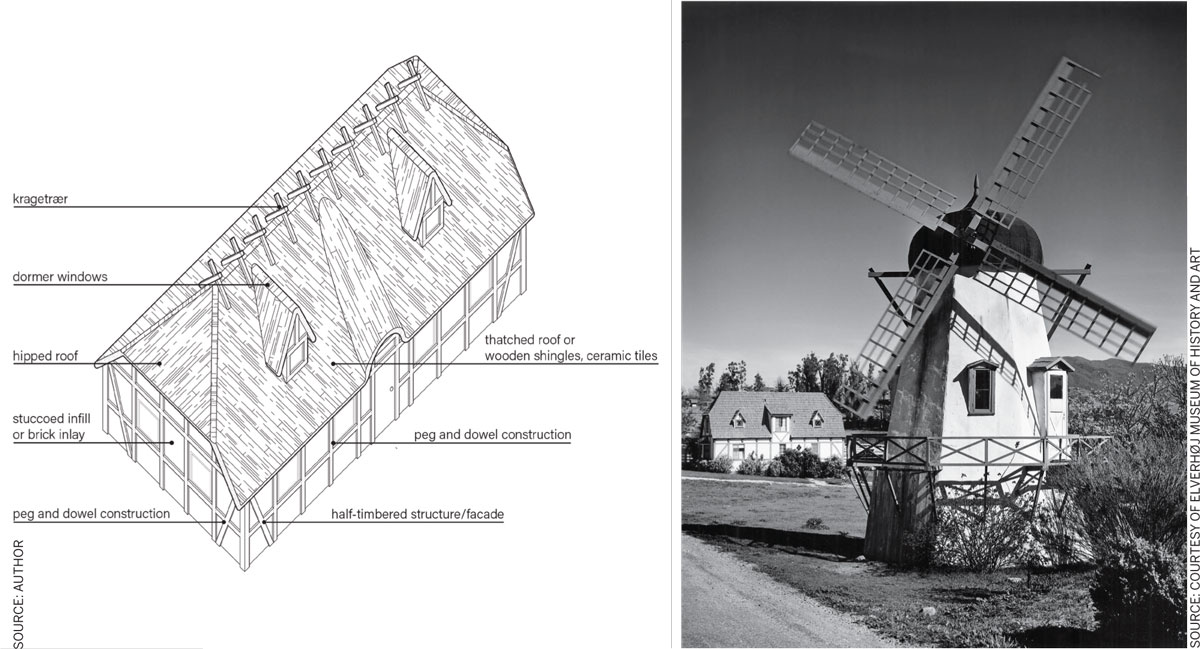
A Half-Timbered Home
Solvang’s Danish architecture may be best understood as an expression of yearning. Louis Hartz theorised that former European colonies develop as ‘fragments’ of their mother countries. When people emigrate, they also bring memories of their homeland. Over time, the mother country evolves and changes, but immigrants’ recollection of it stays the same. In the built environment, this disparity produces allopatric urbanism. In the 20th and 21st centuries, Denmark famously exported high modernist design, exemplified by the minimalist furniture of Kaare Klint to the megastructures of Bjarke Ingels. Meanwhile, Solvang nurtured nostalgia for a timeless memory of Denmark, just like Hans Christian Andersen’s fairy tales did. As the town matured, a local revival of traditional Danish architecture superseded architectural tropes inherited from California.
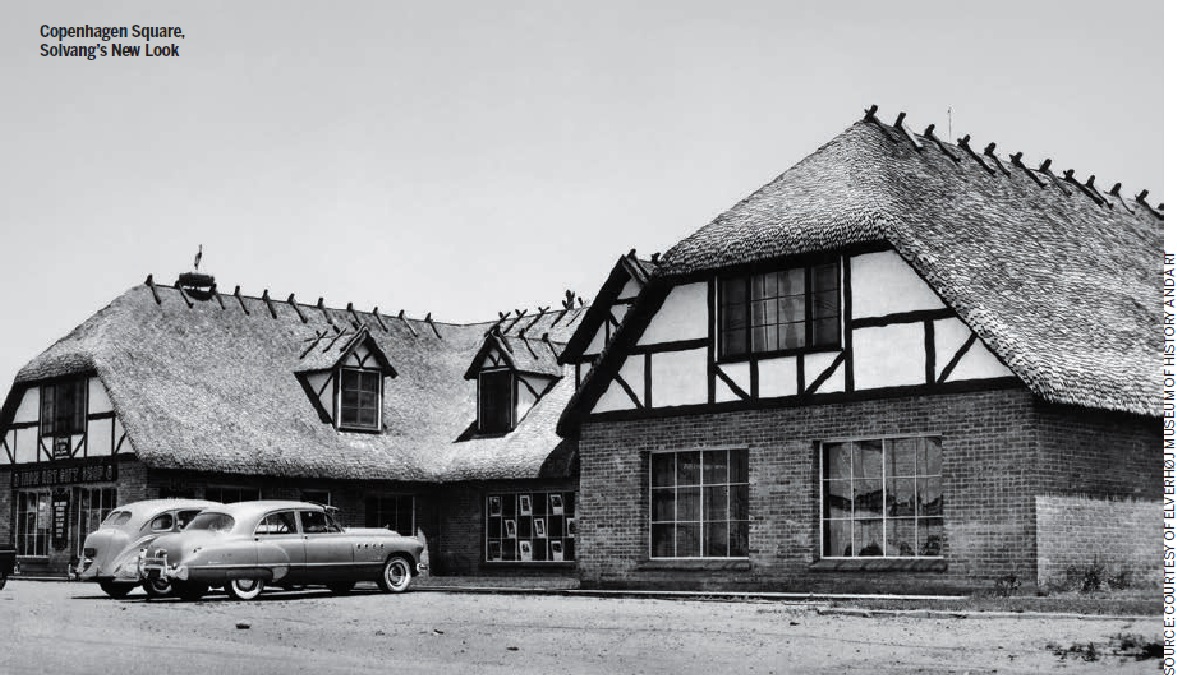
Bethania Lutheran Church is arguably the most accurate translation of Danish architecture into a Californian context, but its specific style wasn’t popularly adopted in Solvang. Next door, a similar-looking elementary school opened in 1940, however the Danish architectural allusion loses clarity when extended to this new typology. There are Jutlandic towns, such as Skagen, where churches, schools and every other building have red roofs and white walls. In California though, these architectural elements could be easily mistaken as a Hispanic homage. This happened to some extent near the Mission Santa Inés, where some buildings survive Solvang’s brief experiment with the Spanish colonial revival style. Instead, the half-timbered look came to define Solvang’s character. Called bindingsværk in Danish, it provides a clear, recognisable architectural symbol for their transplanted identity.
This building tradition began in California as ‘architecture without architects’, to borrow Bernard Rudofsky’s phrase. Eric Thomsen, a minister, was the first vocal advocate for redesigning Solvang according to a bindingsværk ideal. Yet the community, which included non-Danish Americans, resisted a radical redevelopment of Solvang, so the town evolved organically.
Alfred Petersen’s house, built in 1931, was the area’s first half-timbered building. Five years later a jewellery store opened in the bindingsværk style, followed by a cafe in 1939. While the Scandinavian metamorphosis occurred slower than Thomsen envisioned, the process picked up momentum after World War II.
Ferdinand Sorensen, a local Jack-of-all-trades, designed projects that energised the Danish revival. He constructed his own home in the manner of a rustic Danish farmhouse. Its thatched roof even includes kragetrær, criss-crossing wooden beams that project over the ridgeline. Sorensen completed the house in 1945 and two years later built an adjacent windmill containing a garage and a guesthouse. The windmill now marks Solvang’s eastern entrance and is the inaugural addition to the town’s landscape of follies. Raymond Paaske, a local developer, also commissioned Sorensen to design Copenhagen Square, an entire block of Danish-themed stores erected in 1947. A Spanish revival arcade was subsequently converted into a Scandinavian archway, a salient metaphor for the transformation of Solvang’s city image.
Another townsperson, Viggo Brandt-Erichsen, endeavoured to build a liveable Gesamtkunstwerk. A professional sculptor, he revived traditional building techniques to make a true half-timbered structure with intricate brick inlay patterns. In 1953, after four years of meticulous labor, Brandt-Erichsen finally realised his personal monument to Danish architectural craft. Real bindingsværk construction, however, doesn’t perform as well in California as in Denmark. The building required waterproofing and earthquake retrofitting before it reopened as Elverhøj Museum of History and Art in 1988. In contrast, almost every half-timbered facade in Solvang is sculpted from stucco or cement and painted to resemble wood. Despite this illusion, imitation bindingsværk transcends mere surface treatment.
In Solvang, the pragmatic marriage of American construction with Scandinavian forms accommodates the climate and conditions of California while maintaining the imageability of Denmark.

Source: Courtesy of Elverhøj Museum of History and Art
A Danish Destination
What began as an expression of yearning became an alluring tourist attraction during the post-war period. Automobile ownership rose dramatically in the economic boom that followed World War II, enabling the American middle-class to travel freely. Solvang, situated on Highway 101 between Los Angeles and San Francisco, emerged as a convenient way station between the two cities. The Saturday Evening Post, a nationally circulated magazine, ran an article titled ‘Little Denmark’ in 1947. The author lauded Solvang as, “a spotless Danish village that blooms like a rose in California’s charming Santa Ynez Valley.” Overnight, Solvang changed from a rest stop to a destination in its own right.
Local businessmen, recognising a fortuitous opportunity, took the lead in redeveloping the town according to a Danish image. Main Street was rechristened Copenhagen Drive, and other roads were similarly rebranded. All downtown buildings were re-clad or replaced with bindingsværk architecture, but before 1985 there wasn’t even a design review board to enforce the character of the city. A marketable urbanism supplanted individual acts of architecture and the commercialisation of the Danish narrative monopolised the town’s identity. Now there are novelty stores selling Danish kitsch, such as Royal Copenhagen plates depicting sentimental scenes of ordinary life, and restaurants cooking Danish food, notably æbleskivers, fried dough balls covered with raspberry jam and powdered sugar. Danish flavour also extends to cultural events. ‘Danish Days’ began in 1936 as a local celebration of Solvang’s 25th anniversary, which has since recurred annually. Following the Saturday Evening Post article, the holiday exponentially increased in scale, drawing tens of thousands of tourists to the small town. Solvang came to be popularly known as ‘The Danish Capital of America’.

Source: author
A landscape of follies evolved to satisfy visitors’ expectation of the town. As previously mentioned, this trend began innocently enough with Sorensen’s whimsical garage windmill. More quasi-windmills have since proliferated Solvang and neighbouring Buellton. In the movie Sideways (2004), for example, Paul Giamatti and Thomas Haden Church’s characters stay in a windmill hotel during an intemperate road trip to Santa Ynez Valley wine country. The interior programmes of these windmills vary, but outwardly they all function as signposts indicating identity.
Other objects, large and small, populate this landscape as homages to Solvang’s heritage. Behind one of the windmills, a one-third scale replica of Copenhagen’s Rundetårn appeared in 1991. Today, this ‘round tower’ contains a pizza parlour. On the other side of town, a fanciful four-sided Ansonia clock stands on the corner of Mission Drive and Atterdag Road, an oxidised memorial to Solvang’s first settlers (erected in 1985). Tributes to Hans Christian Andersen also abound here. A half-size replica of Edvard Eriksen’s statue, The Little Mermaid, melancholically perches on a fountain in Denmarket Square, while a bust of the author himself overlooks Solvang Park. Both sculptures date to 1976, the year that Queen Margrethe II and her husband Prince Henrik of Denmark paid an official visit to Solvang. The town’s largest park is also eponymously dedicated to Hans Christian Andersen. A fantastical, Scandinavian castle arch from 1971 marks the entrance to this public space. Like the follies of English countryside gardens, these additions to Solvang’s landscape have no other purpose than to delight.

Source: author
The Sun Shines in Solvang
Solvang, born from the memories of a bygone Denmark, isn’t frozen in time itself. A hotel designed by Earl C. Petersen was recently renovated into The Landsby, a boutique hotel and a case study for the town’s evolving character. Studio Collective reimagined the bindingsværk envelope in muted shades of white and updated the interior with contemporary Scandinavian design. The project manifests the urban allopatry between Solvang and Denmark in a single architectural experience. It self-referentially comments on the meaning of ‘Danishness’ in Solvang, and offers a potential direction for the future evolution of ‘Solvangness’. Hanne Pico Larsen defines this identity as a combination of remembering the past and “constantly moulding and discussing [Solvang’s] own content.” Landsby translates to ‘village’, and the hotel’s aesthetics reflect upon and contribute to this town’s identity. The progressive historicism of the Landsby represents one-way Solvang could retain its character while appealing to the region’s oenophilic tourists.
In addition to the architecture, Solvang’s demography has also changed considerably since its founding. People of all races live there now, not just Danes. Elverhøj Museum reflects this plurality, as it maintains dedicated gallery space for local, regional, national and international artwork. The current exhibit, titled ‘Recuérdame/Remember Me’, showcases work by two Mexican American artists, Rosalie M. López and Luis Ramirez. While Solvang maintains a Danish facade, its back of house operations – from the cultivation of grapes to the cooking of æbleskivers – depends on Latino/a labor. As the name of Elverhøj’s installation implies, these and other voices must not be forgotten. Solvang permits tourists to be ‘Danish for a weekend’, but it must also foster a multicultural community if it is to remain a liveable city.
Towns in America and around the world could learn from this village, which nurtures local traditions with international origins. Solvang’s character endures because people endow places with meaning and immigration has defined its genius loci. It’s a small place, yet Solvang symbolises something bigger: people who left their homeland to shape their own destiny. They brought their story with them and, in a land of immigrants, that makes Solvang truly American.

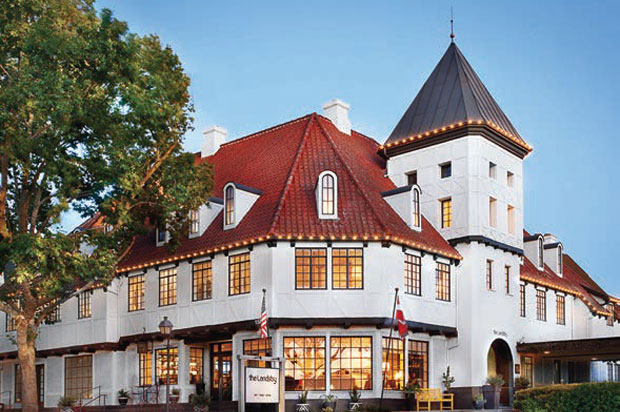

Comments (0)